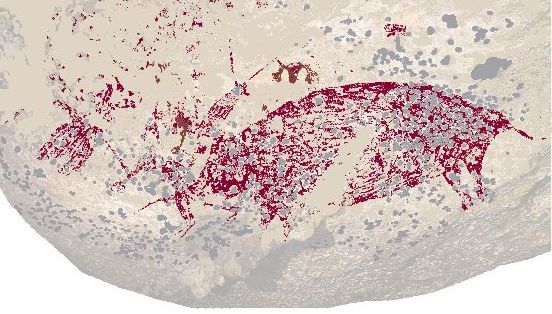
By Dr Joe Milton, the Australian Science Media Centre
A study launched at an AusSMC Briefing this week found an Indonesian cave painting is around 51,200 years old, 6,000 years older than the previous record holder.
Adhi Agus Oktaviana, a PhD student at Griffith University and a lead study author, told journalists at the briefing the findings were “very surprising" because they suggest the painting is much older than the oldest reliably dated ice age art from Europe.
There are even older examples of European cave art, but these are controversial and not widely accepted as accurately dated by the scientific community.
The Indonesian art, found in a cave on the island of Sulawesi, depicts three human-animal hybrids, known as therianthropes, and a wild pig.
“The painting is a narrative composition, a composed scene, depicting three human-like figures interacting with a pig, so it’s the earliest evidence identified for the use of storytelling in art,” said Griffith University archaeologist and study co-author Professor Adam Brumm.
Archaeologists are particularly interested in depictions of therianthropes "because it provides evidence for the ability to imagine the existence of a supernatural being, something that does not exist in real life,” he added.
"Storytelling is a hugely important part of human evolution and possibly even helps to explain our success as a species, but finding evidence for it in art, especially in very early cave art, is exceptionally rare.”
To estimate the age of the art, the team used a new technique, developed by Griffith University's Professor Maxime Aubert and Southern Cross University's Renaud Joannes-Boyau, to determine the age of tiny layers of calcium carbonate that have built up on top of the artwork.
The assumption is that the art must be at least as old as the first layer of calcium carbonate that has formed on top of it.
The scientists measured the ratio of two radioactive substances, uranium and thorium, in these layers to determine their age. The use of uranium and thorium is not new, but the innovation was using lasers to vaporise layers eight times thinner than a hair, allowing them to ensure they were looking at the oldest layer, and not layers that have since formed on top of it.
"The idea is that we create a map of the sample so we understand where the layers are, and then we can actually select the right layers," said Prof Joannes-Boyau.
Prof Aubert said the technique would “revolutionise rock art dating”.
Why these early artists chose to paint a pig isn't entirely clear, but other Indonesian cave paintings from the same period also depict pigs.
Prof Brumm said there's evidence people at the time hunted a species called the Celebes warty pig, which may explain why Sulawesi residents were “besotted” with painting pigs.
You can read about the AusSMC Briefing here
This article originally appeared in Science Deadline, a weekly newsletter from the AusSMC. You are free to republish this story, in full, with appropriate credit.
Contact: Dr Joe Milton
Phone: +61 8 7120 8666
Email: info@smc.org.au